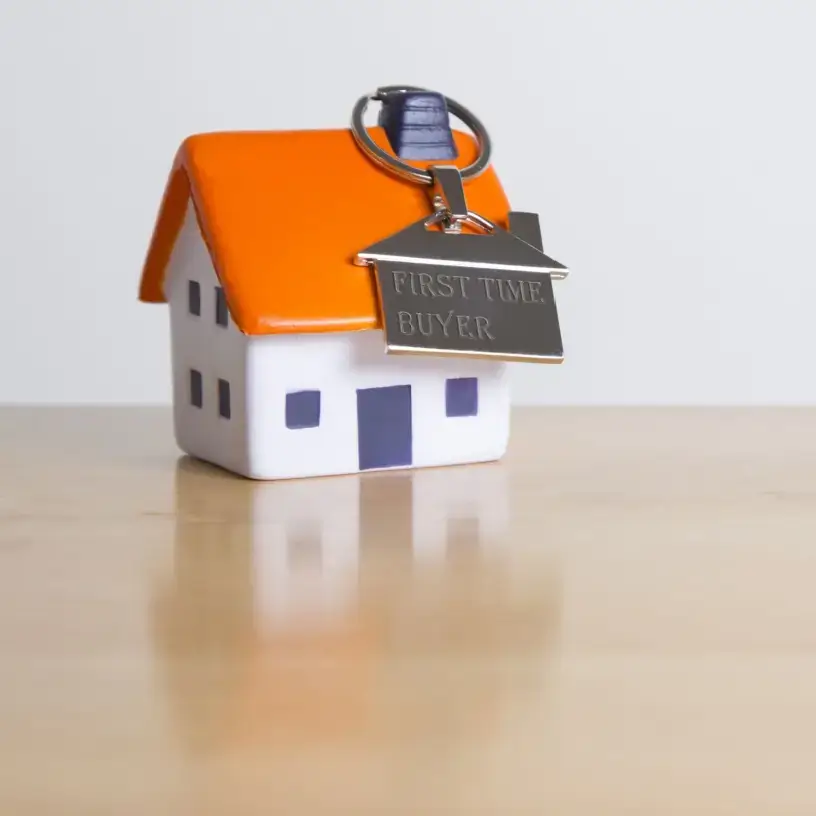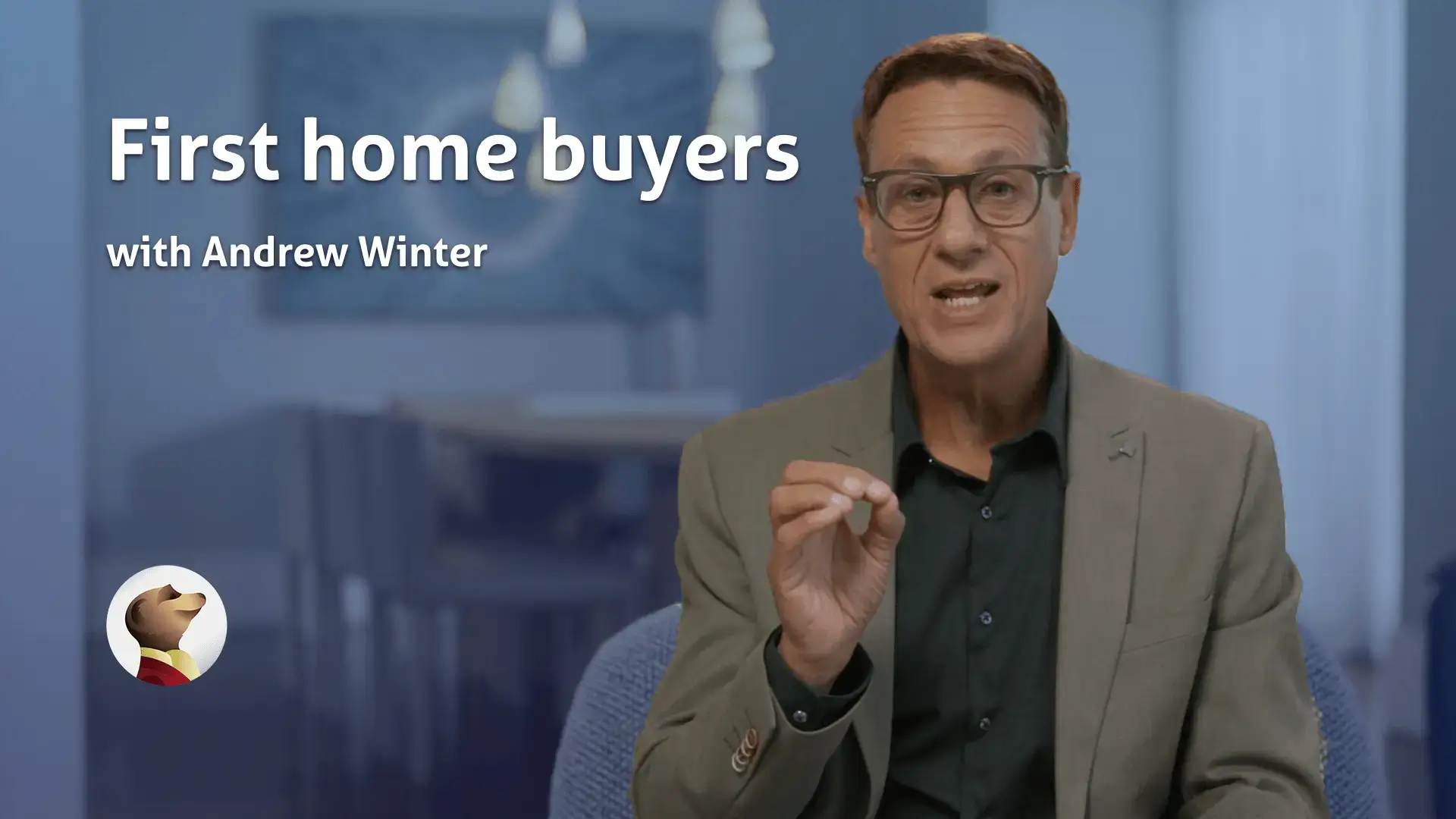Home / Home Loans / First home buyers

Key takeaways
- As a first home buyer, there’s a lot to keep track of when it comes to incentives and grants, how stamp duty works and your various homebuying costs.
- While ‘first home buyer home loans’ aren’t, strictly speaking, a formal product category, many lenders have products and offers designed specifically for first home buyers.
- It’s also important that first home buyers understand how the size of their saved deposit can affect how much their home loan costs them, and how it affects their LVR.
Tips for first home buyers


Hi, I’m Andrew Winter, host of Selling Houses Australia.
I’ve bought, and helped people buy, a lot of homes, but there’s nothing quite like
your first is there?
And yet, while buying a home for the first time is a tremendous accomplishment, getting
there can be a long and strenuous ordeal.
Navigating the various legal and financial hurdles can be a real stress point; let alone
saving your home loan deposit in the first place.
So, to try and save you all a little trouble, here are three essential tips for first home
buyers to keep in mind.
The first is to check what kinds of government assistance you might be able to call upon.
Stamp duty exclusions, cash grants, deposit guarantees; there’s a wide range of initiatives
at both the state and federal levels designed to help you Australians buy their first home.
The second is to make sure you’ve got a clear understanding of what your homebuying
costs will be beyond and outside of your home loan.
Stamp duty, conveyancing costs, application fees; these things can really start to add
up if you haven’t budgeted for them.
That makes it key to do your research and identify your potential homebuying costs ahead of time.
Otherwise, you risk putting a real squeeze on yourself come buying time, which could
have potentially disastrous consequences.
My third and final tip is that you absolutely need to compare your options, to make sure
that when it comes to your home loan, you’re getting the best, not the rest.
So if your gearing up to start house hunting
remember to start loan hunting as well with Compare the Market.
Expert tips for first home buyers
As General Manager of Money at Compare the Market, Stephen Zeller is passionate about equipping first home buyers with the knowledge they need to navigate their first property purchase successfully and with confidence. With that in mind, he has some tips for prospective first-time home buyers:

Research the government assistance available to you
It can seem daunting saving up the money needed to purchase your first home, but thankfully our governments have some great schemes and grants available to help make home ownership a little bit easier. By doing some initial research, you could be saving yourself a small fortune and possibly owning a home sooner than you thought was possible.
Better safe than sorry
Buying a home is one of the biggest financial commitments you’ll make in your life. When you have a home loan, regardless of what time of year it is or if you’re on holiday, you must always make your contracted repayments, so don’t just look at what the repayments are today; ask yourself if you think it would be possible to keep paying the loan if the rate was 2-3% higher. If not, you might need to wait until you have more savings available, or your income has increased.
We’re here to help!
Ask for help. Buying a home and organising home loan finance can be an extremely complicated process, but our team of Home Loan Specialists are ready to help you with any questions you may have, whether this be over the phone or via email. No matter how hard or simple the question may be, our team is here to help you achieve your dreams!
All about first home buyers
What is a first home buyer loan?

Technically, there isn’t really such a thing as a first home buyer loan, although some banks and lenders may offer discounted rates, fees or sign-up incentives for first home buyers. They might also apply slightly different lending criteria for loans to first-time homeowners.
But in most cases, lenders will offer the same products to first home buyers as they would to those who already own a home. This is true for both future owner-occupier borrowers and prospective investors.
Home loan interest rates and fees for first home buyers
First home buyer interest rates
Most first home buyers will generally have access to the same interest rates as existing homeowners, whether they’re buying a residential property or an investment property, although some lenders will offer discounted rates and sign-up incentives for certain first timers.
According to the Reserve Bank of Australia (RBA), the average variable interest rate for new owner-occupier loans in May 2023 was 5.65%, representing an increase from an average rate of 3.51% in August 2019.²
The table below displays the average interest rates on offer across a range of different borrower profiles.
| Loan purpose | Average annual rate for new loans (%) | Average annual rate for outstanding loans (%) |
|---|---|---|
| Owner-occupier | 5.65 | 5.14 |
| Principal and interest | 5.60 | 5.08 |
| Interest-only | 6.29 | 6.58 |
| Investment | 5.93 | 5.45 |
| Principal and interest | 5.84 | 5.40 |
| Interest-only | 6.06 | 5.58 |
| Source: RBA, July 2023 | ||
While some of the differences between the rates in the table above may seem minor, that difference becomes significant in the context of a home loan. Even a minor reduction or increase to your home loan interest rate can have a serious impact on the size of your regular loan repayments. Find out more about your interest rate options, such as fixed interest rates and variable interest rates here.
Home loan fees
Home loans generally come with numerous upfront and ongoing costs, with the most common home loan-related fees being:
- Upfront application, valuation and loan establishment fees
- Conveyancer, legal and registration fees
- Stamp duty
- Ongoing monthly or annual account fees
- Discharge or break fees (applicable if you pay off or switch your home loan).
While these are the more common fees you’ll encounter as a first home buyer, be sure to do your research on any home loan products you’re considering, to make sure you have a thorough understanding of the fees it charges.
Home loan features available to first home buyers
As with interest rates, first home buyers will generally have access to the same range of home loan features as those already on the property ladder. Some of the home loan features that could be available to some home buyers include:
- Offset accounts
- Redraw facilities
- Flexible repayment options, including the option to take a repayment holiday
- Cashback offers and introductory rates
- Package options (e.g. bundled credit card, offset account)
- Split rate option
- Line of credit facility.
In good news for those not looking for any fancy features, ‘no frills’ home loans without any extra features generally come with lower interest rates and fees. So even those looking for simplicity first and foremost can still find a great value home loan that meets their needs.
Government support for first home buyers
First Home Owner Grants (FHOG)
The First Home Owner Grant (FHOG, also known as first home buyer grants) is a once-off lump sum paid towards your home loan for a new home. The FHOG is offered by the Australian Government and funded by each individual state and territory’s government, with each one imposing slightly different rules regarding borrower and property eligibility.
Despite these varying eligibility rules, the thing all states and territories have in common when it comes to the FHOG is that you must be either buying or building a brand new (i.e. never lived in) home to be eligible.
You can find detailed information about the FHOG in your state or territory below (information correct as of July 2023):
- Australian Capital Territory: the ACT scrapped its FHOG as of July 2019, and now offers significant stamp duty concessions for first home buyers instead.³
- New South Wales: First home buyers in NSW can receive $10,000 through the state’s FHOG program.⁴
- Northern Territory: As of May 2019, the FHOG on offer to first home buyers up north is $10,000.⁵
- Queensland: The ‘Sunshine State’ will give $15,000 to eligible first home buyers through its FHOG scheme.⁶
- South Australia: SA’s first-time borrowers can access up to $15,000 in government funding to help them get on the property ladder.⁷
- Tasmania: From April 2021 to June 2024, eligible first home buyers in Tasmania will receive a whopping $30,000 in government assistance.⁸
- Victoria: The Victorian government will contribute $10,000 for its eligible first home buyers.⁹
- Western Australia: First home buyers in the country’s westernmost state could receive up to $10,000 through its FHOG program.¹⁰
If you want to apply for your state or territory’s FHOG, be sure to check the current rules and eligibility requirements to make sure you still qualify.
Stamp duty discounts
You’ll generally have to pay stamp duty when buying a house, which could add up to thousands or even tens of thousands of dollars. Stamp duty, also known as transfer duty, is essentially a tax on sales and transfers of property and land.
While stamp duty can be expensive, many of the country’s state and territories offer stamp duty concessions and discounts for first home buyers, which could save you thousands of dollars.
- Australian Capital Territory: Eligible first home buyers can access up to $34,504 in stamp duty concessions.³
- New South Wales: Depending on the value of the property they’re buying, eligible first home buyers in NSW will either pay no stamp duty or receive a concession on the stamp duty they do have to pay.¹¹
- Northern Territory: The NT does not currently offer any stamp duty-related incentives to its first home buyers.¹²
- Queensland: First home buyers in Queensland can receive up to $15,925 in stamp duty concessions on properties valued under $550,000.¹³
- South Australia: At the time of writing, SA does not have any stamp duty-based incentives in place for first home buyers.⁷
- Tasmania: Australia’s smallest state offers a 50% discount on stamp duty to eligible first home buyers. However, this discount is not available to those who have received or plan on applying for Tasmania’s FHOG.¹⁴
- Victoria: First home buyers in Victoria will pay no stamp duty on properties worth $600,000 or less and will pay a reduced amount of stamp duty on properties worth between $600,000 and $750,000.¹⁵
- Western Australia: WA’s first home buyers will pay no stamp duty on properties with a dutiable value of $430,000 or less and will pay a reduced rate of $19.19 per $100 on the amount that exceeds $430,000 up to $530,000.¹⁶
Visit your state or territory revenue office website for more information on whether you’re eligible for these stamp duty exemptions and discounts and how much they could save you.
The First Home Guarantee (FHBG)
The First Home Guarantee lets 35,000 eligible Australians purchase their first home with a deposit as small as 5%, subject to eligibility requirements.17 The federal government then guarantees up to 15% of the property value, which saves the borrower from having to pay lenders mortgage insurance (LMI). As of July 2023, the eligibility requirements include:
- Australian citizenship or permanent resident
- Being at least 18 years of age
- Earning less than $125,000 as an individual applicant or less than $200,000 as joint applicants
- Intending to be an owner-occupier of the property in question
- Not having owned, or had an interest in, a property in Australia in the past 10 years.
Additionally, the property in question must be either:
- An existing house, townhouse or apartment
- A house and land package
- Land and a separate contract to build a home
- An off-the-plan apartment or townhouse.
Additionally, different postcodes have different property price caps for eligibility, so be sure to check your desired postcode’s price cap before applying for the FHBG.
New Home Guarantee (NHG)
The New Home Guarantee was a government scheme aimed at helping first home buyers buy or build new homes with a deposit as small as 5% of the property value. As of July 2022, the scheme has been brought to an end and is no longer accepting new applicants – however, prospective homebuyers who were considering applying for the NHG may also be eligible for and benefit from the more broadly applicable FHBG.
Many of the eligibility requirements are similar, with the only major difference being the emphasis on helping people buy new homes. That being said, be sure to check the relevant property price caps and eligibility requirements to make sure you’re eligible for the FHBG before applying.
First Home Super Saver Scheme (FHSSS)
The First Home Super Saver Scheme (FHSSS) allows you to voluntarily contribute to your superannuation fund’s balance (either before or after-tax) and use those contributions to form part of your house deposit.¹⁸ Under this scheme, $15,000 worth of your voluntary super contributions can be made per year, up to a total of $50,000 across all years as of July 2023.
You can only request a release under the FHSSS scheme once and it must be for your first home; if you have any outstanding government debt (not including HECS or HELP debts), your withdrawal may be offset by the amount you owe.
The Family Home Guarantee
Under the Family Home Guarantee (FHG), 5,000 single parents per year for a period of four years (15,000 in total from 1 July 2021 to 30 June 2025) will be eligible for a home loan with participating lenders requiring a deposit as small as 2%.¹⁹ The government will guarantee the remaining amount to 18% in order to save the borrower the cost of LMI.
In order to be eligible for the Family Home Guarantee, one must:
- Be single (i.e. you must not have a spouse or a de facto partner, and you must be divorced from a former spouse or partner rather than separated from them. Separation is not considered divorce and a separated individual is not considered single).
- Have at least one dependent child – dependent meaning you’re their natural or adoptive parent – and they either:
- Meet the definition of a ‘dependent child’ as laid out in subsections 2, 3, 4, 5, 6 and 7 of section 5 of the Social Security Act 1991.
- Are at least 16 but under 22 years of age, live with you and receive a disability support pension.
- Not earn more than $125,000 a year
Saving for a home loan as a first home buyer
What is a home loan deposit?

Your home loan deposit is your initial contribution to a property’s purchase. Some form of deposit is generally required to buy a home. The deposit demonstrates your income and ability to save and provides security for the lender giving you a home loan.
It used to be a reliable rule of thumb that you’d want 20% of the property value saved in the form of a deposit, as this would generally prevent you from paying lender’s mortgage insurance (LMI) and help you afford the property. However, with current property prices skyrocketing and even a modest 20% deposit beyond the reach of many would-be first home buyers, 5% has become a more common threshold. This is mainly due to the fact that 5% is the minimum deposit required to be eligible for the FHBG, meaning some first home buyers will only need 5% of a property’s value saved before they can potentially purchase it with government assistance.
Something worth keeping in mind, however, is the fact that you’ll also need to account for costs on top of your saved 5% deposit. This includes fees and upfront costs that can’t be rolled into your home loan, including:
- Legal and conveyancing costs
- Pest inspection costs
- Stamp duty and transfer fees
- Mortgage application and registration fees
What is LVR?
LVR is your loan-to-value ratio, which shows how much you’ve borrowed relative to the value of the property in question. This means your LVR will be affected by the size of your deposit.
For example, if you borrow $480,000 to help purchase a $600,000 property, your deposit is 20%, meaning you still owe 80% of the property’s value to your lender. In this instance, your LVR would be 80.
A higher LVR could lead to a bank imposing a higher interest rate on your home loan, due to its perceived higher risk.
What is Lenders Mortgage Insurance (LMI)?
Generally speaking, if your LVR is above 80% (i.e. your deposit is below 20%), your lender could make you take out lenders mortgage insurance (LMI) as a condition of your home loan.
LMI is an insurance policy that lenders can utilise to protect themselves against the risk of a borrower defaulting on their home loan repayments. Having to pay LMI can often cost you thousands of dollars either upfront or over the life of a home loan and can drive up the loan amount and ongoing costs of buying a home – however, it can also be the difference between being able to purchase a home or not, so it could ultimately represent a net positive for some homebuyers.
As discussed, however, the FHBG can help you avoid paying LMI by guaranteeing up to 15% of your property’s value, with a minimum of 5% required on your end. This means that you will not be required to pay LMI if you meet the FHBG eligibility criteria.
Property-buying costs for first home buyers
Stamp duty
As mentioned, stamp duty is a type of tax imposed by states and territories during the sale of a property. Stamp duty costs vary in each state and territory, but in most cases, will be in the thousands or tens of thousands of dollars.
Below is a table illustrating how much stamp duty homebuyers would pay nationwide, based on each state or territory’s average dwelling price and stamp duty rates.²⁰ Average dwelling prices are for the March 2023 quarter, and our stamp duty calculations are an estimate and do not account for any exemptions or concessions you may be eligible for.
| State/Territory | Average dwelling price | Stamp duty payable |
|---|---|---|
| ACT | $951,800 | $31,660.20 |
| NSW | $1,150,400 | $46,503 |
| NT | $502,100 | $24,098.39 |
| QLD | $752,200 | $19,699 |
| SA | $644,300 | $29,266.50 |
| TAS | $655,800 | $24,869 |
| VIC | $898,300 | $48,668 |
| WA | $651,700 | $24,970.75 |
Most of Australia’s states and territories either waive or discount stamp duty for first home buyers, making it less of an obstacle to home ownership. However, property price caps apply, so check your state or territory’s relevant caps before applying for a concession or exemption.
Insurance
You’ll generally want to be ahead of the game when it comes to home insurance, as most lenders will only arrange for settlement after being named as the financial institution on a home insurance policy attached to the property in question.
While you can be approved for a home loan before having home insurance, lenders will generally need you to have insurance before taking ownership of the property.
However, exact timelines will vary depending on your state or territory. In some states and territories, the buyer becomes responsible for any damage to the property on or after the settlement date. In others, they may become responsible as soon as the contract is signed. This may affect your decision as to when you formally take out a home insurance policy. Still, it’s generally a good idea to act as early as is feasible and reasonable.
The only notable exception is for properties under strata title, in which case insurance may be arranged and paid for through strata fees and levies.
Inspections
Building and pest inspections are not compulsory in most cases but are highly recommended. These inspections and other due diligence enquiries can help identify any potential problems with a property, potentially lowering the asking price or even helping you decide against buying it.
While you may be reluctant to opt into yet another cost, outlaying a little extra cash before buying a home is better than finding out it’s termite-ridden after you’ve bought it.
Conveyancing
It’s generally recommended (and often required) that you engage a conveyancer or solicitor ahead of signing a Contract of Sale to check to check the legalities and terms of the contract, help you conduct due diligence on the property and ensure the official process runs smoothly. Unless you’re a lawyer by trade, trying to navigate the legalities of the homebuying process yourself is not recommended.
Read more about conveyancers here, including how much they can cost and what they can do for you.
How to apply for a loan as a first home buyer
Check your borrowing power

Borrowing power is the maximum estimated amount you’ll be able to borrow for a home loan. This is calculated using things like income, your household expenditure, deposit size, number of dependents and desired home loan term.
You should get an understanding of your borrowing power before applying for a home loan so you have a general idea of how much you might be eligible to borrow.
Consider pre-approval
It may be a good idea to seek pre-approval on a loan before you make any offers on a home. Home loan pre-approval can give you a much more accurate understanding of your borrowing power and what type of home you can realistically afford. It can also help you avoid wasting your time on properties you can’t afford in the first place.
Check the eligibility criteria
When you’re in the market for a home loan, each lender will have specific eligibility requirements you’ll need to meet. Some of them are common across most lenders (e.g. being 18 years of age or older and a permanent resident of Australia), but others may be more niche and specific to one lender.
Check the key fact sheet or ask about lender requirements before you apply.
Get your documents ready
As you can imagine, when you apply for a home loan, you’ll need to submit some documents. These can include, but aren’t limited to:
- Primary and secondary forms of identification
- Proof of employment and recent payslips
- Details of your assets and financial situation, including any outstanding debts or lines of credit.
For more details on what info you might need to submit, we’ve compiled a list of the most common documents you’ll need.
Find the right home loan
It’s vital that you compare a broad range of home loan products based on your needs, and look at things like interest rates, fees, repayment types, features and loan terms.
Meet our home loans expert, Stephen Zeller
Stephen has more than 30 years of experience in the financial services industry and holds a Certificate IV in Finance and Mortgage Broking. He’s also a member of both the Australian and New Zealand Institute of Insurance and Finance (ANZIIF) and the Mortgage and Finance Association of Australia (MFAA).
Stephen leads our team of Home Loan Specialists, and reviews and contributes to Compare the Market’s banking-related content to ensure it’s as helpful and empowering as possible for our readers.
Want to know more about home loans?
- Australian Bureau of Statistics (ABS), Lending Indicators, May 2022. Accessed July 2023.
- Reserve Bank of Australia (RBA), Lenders’ Interest Rates, April 2022. Accessed July 2023.
- ACT Revenue Office, Home buyer concession scheme (from 1 July 2019). Accessed July 2023.
- NSW Government, First home buyer grants and assistance. Accessed June 2023.
- NT.GOV.AU, First home owner grant. Accessed June 2023.
- Queensland Government, Queensland First Home Owners’ Grant. Accessed June 2023.
- RevenueSA, First Home Buyer. Accessed June 2023.
- State Revenue Office of Tasmania, First Home Owner Grant. Accessed June 2023.
- State Revenue Office Victoria, Applying for the First Home Owner Grant. Accessed June 2023.
- WA.gov.au, First home owner grant (FHOG). Accessed June 2023.
- Revenue NSW, First Home Buyer. Accessed July 2023.
- NT.GOV.AU, Territory home owner discount. Accessed June 2023.
- Queensland Government, First home concession. Accessed June 2023.
- State Revenue Office of Tasmania, Property Transfer Duties. Accessed June 2023.
- State Revenue Office Victoria, First home buyer duty exemption, concession or reduction. Accessed June 2023.
- WA.gov.au, Duties Fact Sheet – First Home Owner Rate. Accessed June 2023.
- National Housing Finance and Investment Corporation, First Home Guarantee. Accessed July 2023.
- Australian Taxation Office, First home super saver scheme. Accessed June 2023.
- National Housing Finance and Investment Corporation, Family Home Guarantee. Accessed June 2023.
- Australian Bureau of Statistics, Total Value of Dwellings. Accessed March 2023.





